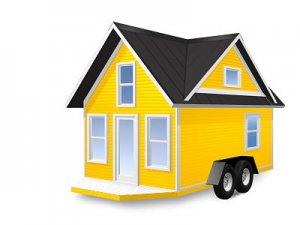|
|
 Unless you’ve been under a rock for the past couple years, you are aware of the tiny house movement that is taking the country by craze.
Unless you’ve been under a rock for the past couple years, you are aware of the tiny house movement that is taking the country by craze.
In case you’re one of the folks who is not familiar with this concept, tiny houses are exactly what they sound like: super small houses, usually under 300 square feet, that are designed in such a way to maximize space, while using virtually no space at all. They can be stationary on the ground but in many cases, they’re built on a trailer so they’re mobile.
The movement began way back at the beginning of the century but lately, it has exploded thanks to this new generation of consumers and the media. There are all kinds of TV shows focusing on tiny homes like Tiny House Hunters on HGTV. If you Google tiny house you’ll find a very vibrant community where owners exchange information and offer advice on living in small space.
Here’s a look at the typical tiny housebuyer:
- They have an average income of $42,038 ($478 higher than the average American)
- 89% of tiny house owners have less credit card debt than the average American
- 65% of tiny house owners have no credit card debt
- 55% of tiny house owners have more savings than the average American
- 68% of tiny house owners have no mortgage (compared to 29.3% of all US homeowners)
- 2 out of 5 tiny house owners are over 50 years of age
While all of this is fascinating just on the surface, when we dig deeper – I think this movement is a huge wake-up call to marketers. There are some pretty significant clues in this phenomenon as to where consumers are heading and that’s going to impact us all.
Here are some of the trends I see buried in the tiny house movement:
Independence as a core theme: Imagine all the levels of freedom you’d have if your house could be moved anywhere you wanted it to be, you didn’t have a mortgage and your housing costs were power, water, Internet, and insurance.
A return to a simpler life: Tiny home buyers want to owe less, so they have more choices in terms of spending time with their family, work less and have a lot less to maintain. By default – if you live in 350 square feet, you can’t have a lot of stuff. Simpler by default.
A different definition of success: For these consumers, success isn’t a big house with a big screen TV and a beautifully manicured lawn. It’s no debt and no strings. This frees the homeowners up to spend more time traveling and being out and about.
Mobility: By default, if your house is on wheels – you don’t plan on setting down permanent roots. Even if you stay in the same community, you’re not tied down.
Eco-friendly: These homes are very eco-friendly with composting toilets, very little energy usage, solar panels and multi-use furniture. The footprint created by one of these homes is minuscule compared to a traditional home.
A new relationship with money: These consumers are not willing to owe anyone anything. They want the economic freedom to do what they want when they want. But that doesn’t mean they don’t like nice things. Many tiny homes have very high-end appliances and finishes like cherry-wood floors and stained glass windows. When you’ve got less than 500 square feet, those kinds of upgrades are very affordable.
This consumer group is growing at an amazing rate. Even if someone doesn’t opt for a tiny home, it’s safe to assume these consumer attitudes are emerging among the more traditional homeowner as well.
These attitudes and buying patterns are going to trickle into every category. I think it’s important that you begin to think about how this is going to translate to your business. Because if it hasn’t already – it’s coming.
